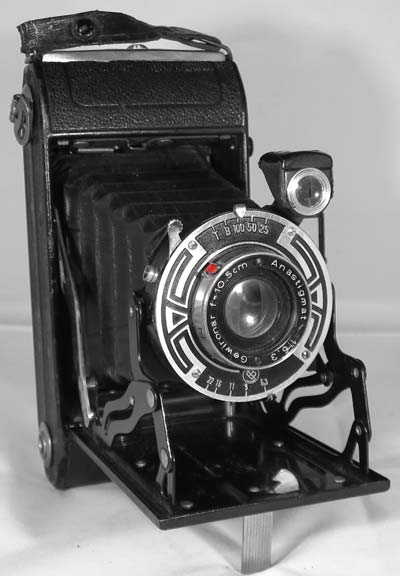Wirgin Spidex A
Specification

| Manufacturer | : | Wirgin |
|---|---|---|
| Produced | : | 1935 |
| Classification | : | Medium Format |
| Body Type | : | Folding Bed |
| Bellows Deployment | : | Self Erecting |
| Construction | : | Metal |
| Film Type | : | 120 |
| Film Width | : | 62mm |
| ImageSize | : | 2¼ x 3¼ in |
| No. of Images | : | 8 |
| Lens Type | : | Gewironar Anastigmat |
| Focal Length | : | 105mm |
| Focus Type | : | Variable |
| Focal Range | : | 7ft - inf. |
| Aperture Type | : | Iris |
| Aperture | : | f/6.3 - f/22 |
| Shutter Type | : | 2 Leaf |
| Shutter Speeds | : | T,B,1/25,1/50,1/100 sec |
| Size Closed (w x h x d) | : | 87 x 160 x 35 mm |
| Size Open (w x h x d) | : | 87 x 160 x 135 mm |
| Weight | : | 636g |
Art Deco Credentials
![]()
![]()
![]()
![]()
Significant: Pronounced and self evident
- Produced during the main Art Deco period.
- Geometric pattern in chrome on black enamel on faceplate.
- Curvilinear body design.
- Leatherette with embossed diamond pattern on top and bottom.
- Chrome and black enamel brilliant finder.
- Ornate chrome and black struts.
- Ornate chrome winder and film door latch.
- Chrome table stand, tripod sockets and red window.
Description
The Spidex A is a folding camera made by Wirgin in the 1930s. It takes eight 6 x 9 cm images on 120 roll film. The camera is self-erecting, with a button to release the front next to the frame viewfinder. The lens is a 10.5 cm, f/6.3 Gewironar Anastigmat. Focus is by turning the front lens mount. The focus is adjustable down to 7 feet and slightly below. It has a Stein und Binneweg shutter with speeds 1/25 - 1/100 second, plus 'B' and 'T'.
The main viewfinder is a double frame type. There is also a brilliant finder mounted on the lens standard, which swivels for horizontal and vertical use. There is a sliding button on the back which controls a cover for the red window. The film compartment opens with a small sliding latch, marked with an arrow, under the carrying strap. The camera has two 1/4 inch tripod mounts.
How to Use
Shutter speeds are 1/25s, 1/50s and 1/100s although the accuracy is not guaranteed. The aperture range is f/6.3 to f/22
If you don't want to bother with an exposure meter, follow the guide shown. It is based on the 'Sunny 16' rule. Film is so forgiving and will produce acceptable results even when overexposed by 2 or 3 stops or underexposed by 1 stop.
Remember that the exposure guide in the camera user manual may not be helpful as it is based on the use of old film with a low ISO value.
The tables assume that the sun is at least 30 degrees above the horizon - that's 10am - 5pm on a summer's day in the UK.
If you are not sure about the light level, err on the side of overexposure - i.e. assume the smaller f number.
Where there is a choice, a larger f number will give a larger depth of field.
For the slower speeds, you may need a tripod to stop blur through shake.
The results shown in green show perfect exposure. The results shown in amber will give acceptable results. Results in red are unacceptable.
Using ISO 100/125 film
| Weather Conditions | Shadow Detail | Shutter Speed (s) | ||
|---|---|---|---|---|
| 1/25 | 1/50 | 1/100 | ||
 Sunny SunnySnow/Sand | Dark with sharp edges | f/22 | f/22 | f/22 |
 Sunny Sunny | Distinct | f/22 | f/22 | f/16 |
 Slight Overcast Slight Overcast | Soft around edges | f/22 | f/16 | f/11 |
 Overcast Overcast | Barely visible | f/16 | f/11 | f/8 |
 Heavy Overcast Heavy Overcast | None | f/11 | f/8 | f/6.3 |
 Open Shade Open Shade/Sunset | None | f/8 | f/6.3 | f/6.3 |